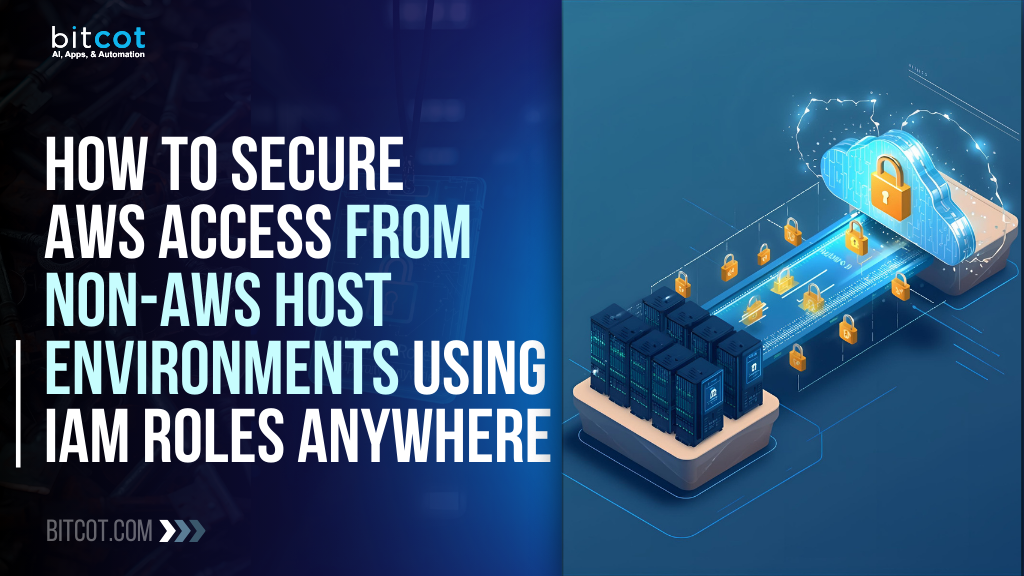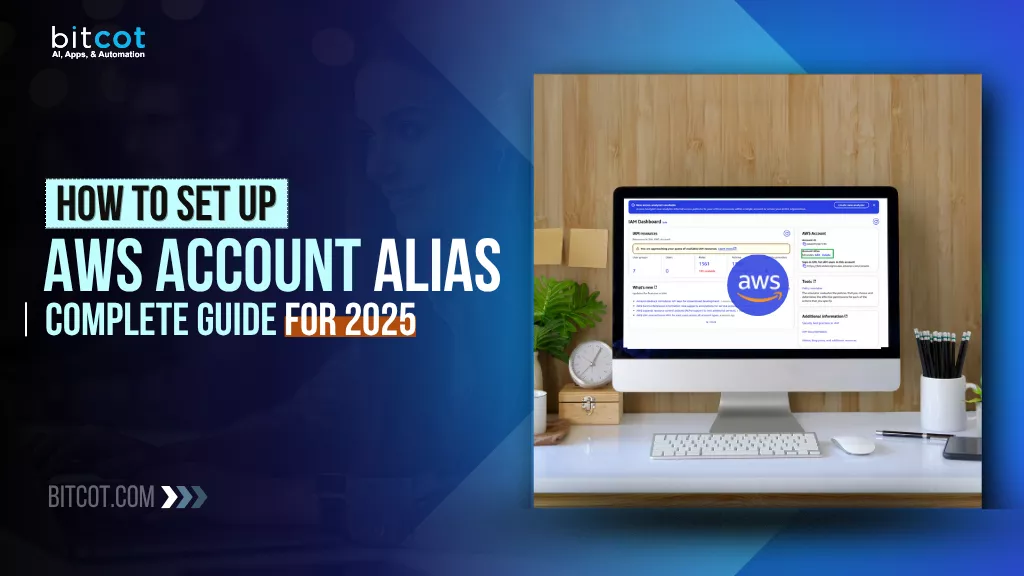
Are your team members still struggling to remember that cryptic 12-digit AWS account ID every time they need to sign in?
You’re not alone. Every day, thousands of AWS users waste precious minutes fumbling with lengthy account numbers, bookmarking complex URLs, or worse – sharing login credentials through insecure channels.
But there’s a simple solution that takes just 2 minutes to implement and transforms your entire team’s AWS experience.
Tired of sharing that long, confusing 12-digit AWS account ID with your team? Creating an AWS account alias transforms your sign-in URL from a string of numbers into something memorable and professional.
This comprehensive guide walks you through everything you need to know about AWS account aliases in 2025, from basic setup to enterprise-scale management strategies.
Whether you’re managing a small development team or overseeing hundreds of AWS accounts across multiple departments, this guide provides the complete roadmap to implement professional, secure, and memorable AWS sign-in URLs that your team will actually use.
What is an AWS Account Alias and How Does It Work?
An AWS account alias is a custom, user-friendly name that replaces your numerical AWS account ID in the AWS Management Console sign-in URL. Instead of asking your team members to remember a 12-digit number like 123456789012, you can create a memorable alias like mycompany-aws for easier AWS console login access.
Default vs. Aliased Sign-In URLs
Default URL format:
https://123456789012.signin.aws.amazon.com/console
With account alias:
https://mycompany-aws.signin.aws.amazon.com/console
The original numerical URL remains active even after creating an alias, ensuring backward compatibility.
Now that you understand what an AWS account alias is, let’s explore the specific benefits it can provide for your organization and team workflow.
Benefits of Setting Up AWS Account Alias for Your Organization
Creating an AWS account alias delivers immediate improvements in user experience, security, and organizational efficiency for teams of all sizes.
Enhanced User Experience
- Memorable URLs: Easy-to-remember sign-in links for your team
- Professional appearance: Brand-consistent AWS console login pages
- Simplified access: Reduce login friction for frequent users
- Custom domain feel: Professional-looking AWS sign-in URL without complex setup
Security Benefits
- Reduced credential sharing: Teams can bookmark professional URLs
- Audit trail clarity: Cleaner CloudTrail logs with recognizable identifiers
- Access management: Easier to identify which AWS account users are accessing
- IAM integration: Seamless integration with AWS Identity and Access Management
Organizational Benefits
- Brand consistency: Align AWS access with company branding
- Multi-account management: Distinguish between different environments (dev, staging, prod)
- Team onboarding: Simplified access for new team members
Understanding these benefits is important, but before creating your alias, you need to be aware of the specific requirements and limitations that AWS imposes on account aliases.
AWS Account Alias Requirements and Best Practices 2025
Understanding AWS’s technical requirements and current best practices ensures your alias implementation meets both compliance standards and organizational needs.
Technical Requirements
- Length: 3-63 characters
- Characters allowed: Lowercase letters (a-z), numbers (0-9), and hyphens (-)
- Global uniqueness: Must be unique across all AWS accounts worldwide
- Format restrictions: Cannot start or end with a hyphen
- AWS CLI compatibility: Works with list-account-aliases and create-account-alias commands
Important Limitations
- One alias per account: Each AWS account can have only one active alias
- Public visibility: Aliases appear in public-facing URLs (avoid sensitive information)
- Overwrite behavior: Creating a new alias overwrites the previous one
- No special characters: Underscores, periods, and uppercase letters are not allowed
With these requirements in mind, you’re ready to create your AWS account alias. The following section provides multiple methods to set up your custom sign-in URL.
Step-by-Step Guide: How to Create AWS Account Alias
Follow these detailed instructions to set up your custom AWS sign-in URL using the console, CLI, or API methods.
Method 1: Using AWS Management Console
Step 1: Access the IAM Console
- Sign in to the AWS Management Console
- Navigate to the IAM service dashboard
- Ensure you have administrator privileges or the required IAM permissions for account alias management
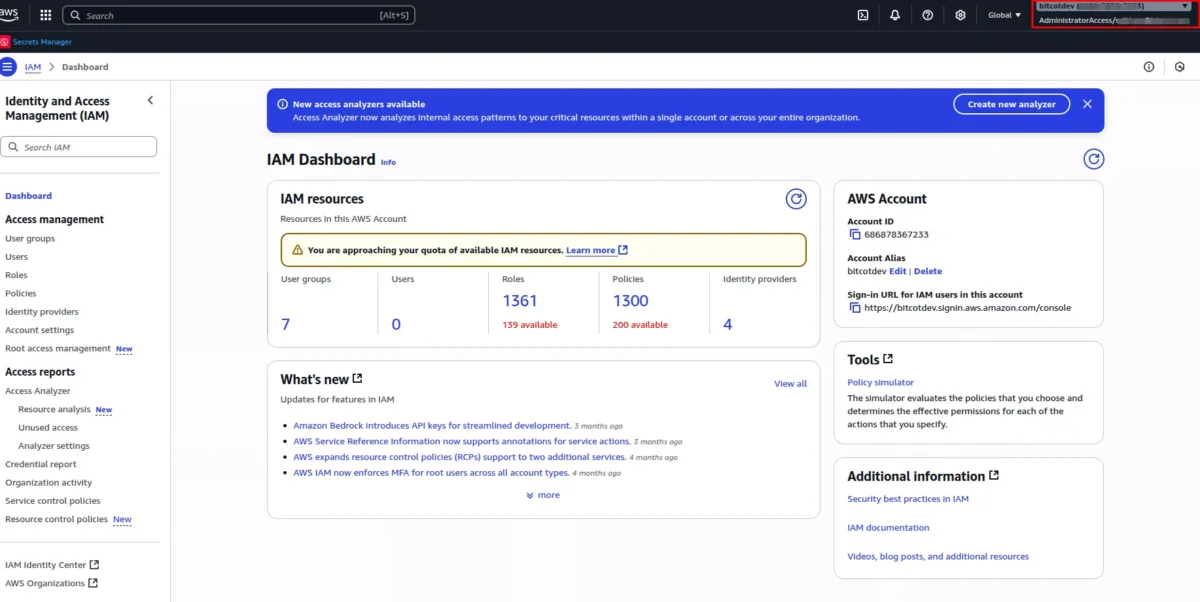
Step 2: Create the Account Alias
- In the IAM dashboard, locate the “AWS Account” section on the right panel
- Find “Account Alias” and click Create (or Edit if an alias exists)
- Enter your desired alias following the naming requirements
- Click Save changes
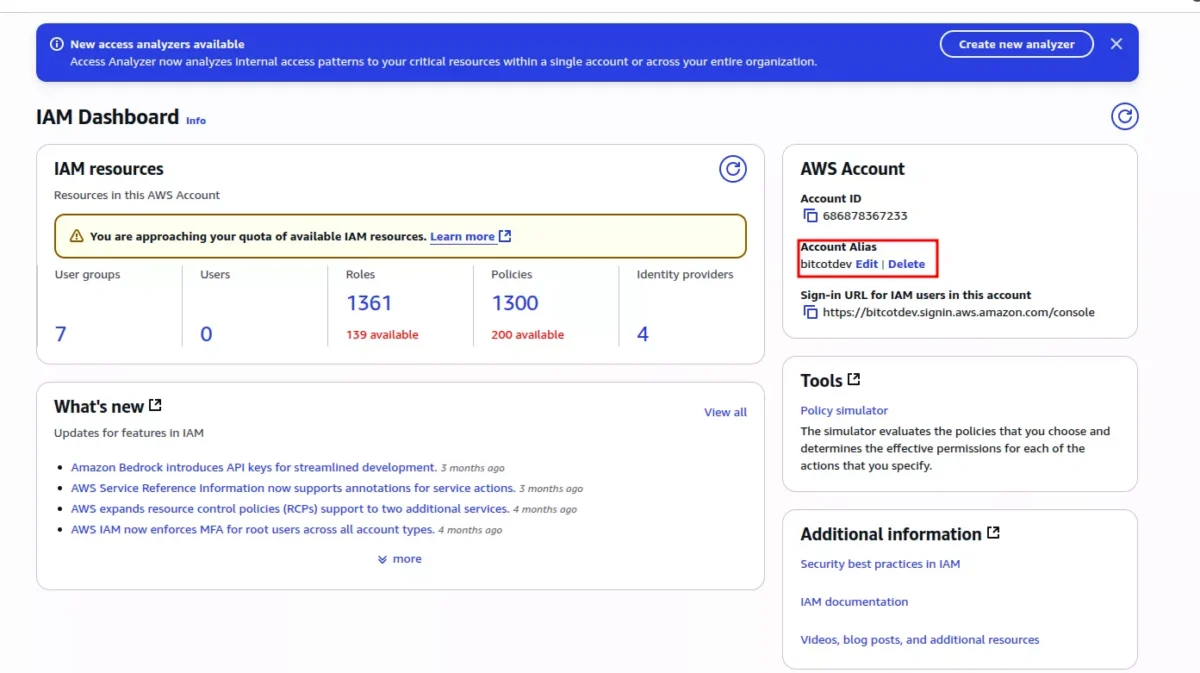
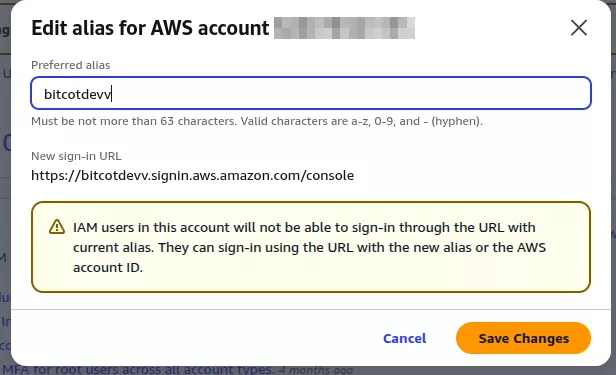
Step 3: Verify the Setup
- Check the “Sign-In URL” section to see your new custom URL
- Test the new URL in a private/incognito browser window
- Bookmark the new URL for easy access
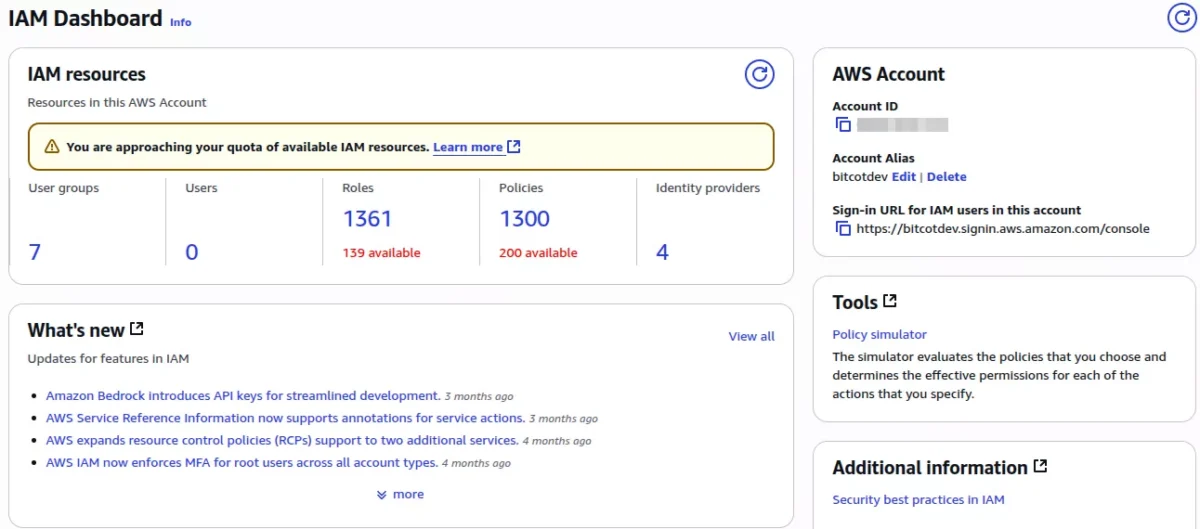
Method 2: Using AWS CLI
Prerequisites
- AWS CLI installed and configured
- Appropriate IAM permissions
Create Alias Command
aws iam create-account-alias --account-alias your-company-name
List Current Alias
aws iam list-account-aliases
Delete Account Alias
aws iam delete-account-alias --account-alias your-company-name
Method 3: Using AWS API
Create Account Alias
POST / HTTP/1.1
Host: iam.amazonaws.com
Content-Type: application/x-amz-json-1.1
X-Amz-Target: AWSIAMService.CreateAccountAlias
{
"AccountAlias": "your-company-name"
}
Once you have the proper permissions configured, it’s crucial to follow established best practices to ensure your alias serves your organization effectively and securely.
Whether you choose the console, CLI, or API method, you’ll need appropriate IAM permissions to manage account aliases. Let’s examine the specific permissions required for alias management.
IAM Permissions Required for AWS Account Alias Management
Proper IAM permissions are essential for creating, modifying, and deleting account aliases while maintaining security best practices.
To manage account aliases, users need specific IAM permissions:
{
"Version": "2012-10-17",
"Statement": [
{
"Effect": "Allow",
"Action": [
"iam:CreateAccountAlias",
"iam:DeleteAccountAlias",
"iam:ListAccountAliases"
],
"Resource": "*"
}
]
}
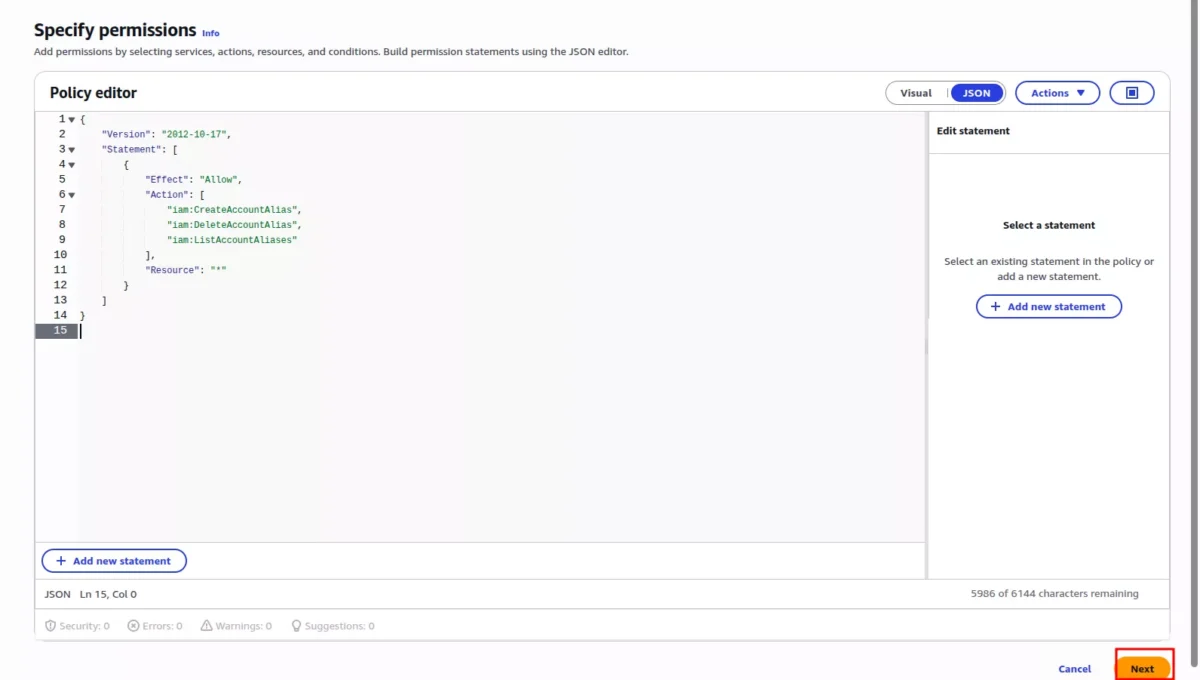
AWS Account Alias Best Practices and Naming Conventions
Implementing proven naming strategies and organizational guidelines maximizes the value and consistency of your AWS account aliases.
Naming Conventions
- Use your company name: acme-corp-aws or acme-production
- Include environment: mycompany-prod, mycompany-dev, mycompany-staging
- Keep it short: Aim for 15-25 characters for better usability
- Avoid abbreviations: Use clear, self-explanatory names
Security Considerations
- No sensitive information: Never include passwords, API keys, or confidential data
- Consider public visibility: Remember that aliases appear in public URLs
- Regular review: Periodically audit and update aliases as needed
- Documentation: Maintain a record of aliases across multiple AWS accounts
Even with careful planning, you may encounter issues when creating or using AWS account aliases. The next section covers common problems and their solutions.
Organizational Guidelines
- Standardize format: Establish consistent naming patterns across accounts
- Environment separation: Use different aliases for different environments
- Team coordination: Ensure aliases don’t conflict with existing infrastructure
Common AWS Account Alias Issues and Solutions
Resolve frequent problems like “alias already exists” errors, permission issues, and URL access problems with these proven troubleshooting steps.
“Alias Already Exists” Error
This error occurs when trying to use an alias that’s already taken globally. Try these solutions:
- Add your company name or unique identifier
- Include the year or specific project name
- Use variations with hyphens to create unique combinations
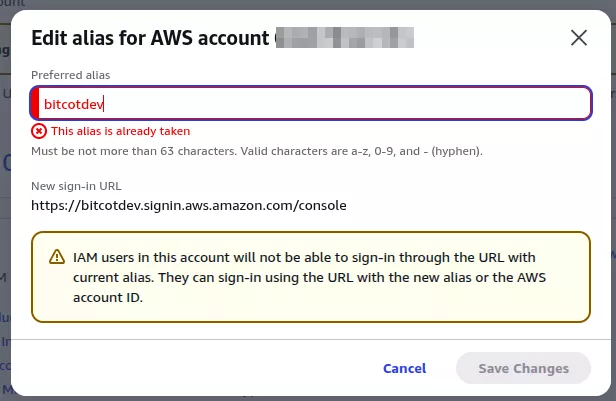
Permission Denied Errors
Ensure your user has the required IAM permissions:
- iam:CreateAccountAlias
- iam:DeleteAccountAlias
- iam:ListAccountAliases
URL Not Working After Creation
- Clear browser cache and cookies
- Try accessing the URL in an incognito/private window
- Verify the alias was created successfully using aws iam list-account-aliases
- Check for typos in the alias name
For organizations with more complex requirements, there are advanced configuration options that can enhance your AWS account alias implementation.
Advanced AWS Account Alias Configuration for Enterprise
Enterprise environments require sophisticated alias management strategies including AWS Organizations integration and Infrastructure as Code automation.
Using AWS Organizations
For organizations with multiple AWS accounts, consider:
- Centralized naming: Establish organizational naming conventions
- Account tagging: Coordinate aliases with account tags
- Cross-account access: Ensure aliases support federated access patterns
Integration with CI/CD Pipelines
Automate alias creation in infrastructure as code:
Terraform Example
resource "aws_iam_account_alias" "alias" {
account_alias = "mycompany-production"
}
CloudFormation Example
AWSTemplateFormatVersion: '2010-09-09'
Resources:
AccountAlias:
Type: AWS::IAM::AccountAlias
Properties:
AccountAlias: mycompany-production
While implementing these advanced configurations, it’s essential to maintain proper security and compliance standards throughout your alias management strategy.
AWS Account Alias Security and Compliance Guidelines
Maintain robust security posture and meet compliance requirements through proper audit trails, access controls, and monitoring practices.
Audit Trail
- Account alias changes are logged in AWS CloudTrail events
- Monitor CreateAccountAlias and DeleteAccountAlias API calls
- Set up CloudWatch alerts for unauthorized alias modifications
- Track sign-in URL usage patterns for security analysis
Compliance Requirements
- Document alias usage in security policies
- Include alias management in access reviews
- Consider regulatory implications of custom URLs
As your AWS environment grows, you’ll need effective strategies for managing aliases across multiple accounts and handling migrations when changes are necessary.
Managing Multiple AWS Account Aliases at Scale
Scale your alias management across dozens or hundreds of AWS accounts with standardized processes, documentation, and migration strategies.
Updating Existing Aliases
- Plan the change: Notify team members in advance
- Update bookmarks: Provide new URLs to all users
- Monitor access: Watch for users still using old URLs
- Update documentation: Ensure all references are updated
Managing Multiple Accounts
- Create spreadsheet: Track aliases across all accounts
- Use consistent patterns: Make aliases predictable
- Regular audits: Review and validate all aliases quarterly
Finally, let’s examine the cost implications and performance considerations to ensure you have a complete understanding of AWS account aliases.
Cost and Performance Impact
Account aliases provide significant organizational benefits with zero direct costs and no impact on AWS service performance or console loading times.
Cost Implications
- No direct costs: Account aliases don’t incur additional AWS charges
- Management overhead: Consider time investment for setup and maintenance
Performance Considerations
- No performance impact: Aliases don’t affect AWS service performance
- DNS resolution: Custom URLs resolve just as quickly as default URLs
- Console login speed: No difference in AWS Management Console loading times
Conclusion
Setting up an AWS account alias is a simple yet powerful way to improve your team’s AWS experience. By following the best practices outlined in this guide, you’ll create memorable, professional URLs that enhance security and usability.
Remember to:
- Choose clear, professional aliases
- Follow naming conventions consistently
- Keep security considerations in mind
- Document your aliases for future reference
Whether you’re managing a single AWS account or multiple environments, account aliases provide a professional, user-friendly way to access your AWS resources.
Need help implementing AWS account aliases or other AWS security best practices? Contact our AWS experts for professional consultation and implementation services.
Frequently Asked Questions
Can I have multiple aliases for one AWS account?
No, each AWS account can have only one active alias at a time.
What happens to the original URL after creating an alias?
The original numerical URL remains active and functional alongside the new alias URL.
Can I use uppercase letters in my alias?
No, aliases must contain only lowercase letters, numbers, and hyphens.
How long does it take for an alias to become active?
Account aliases are typically active immediately after creation.
Can I revert to using just the account ID?
Yes, you can delete the alias, and your account will revert to using only the numerical ID.





